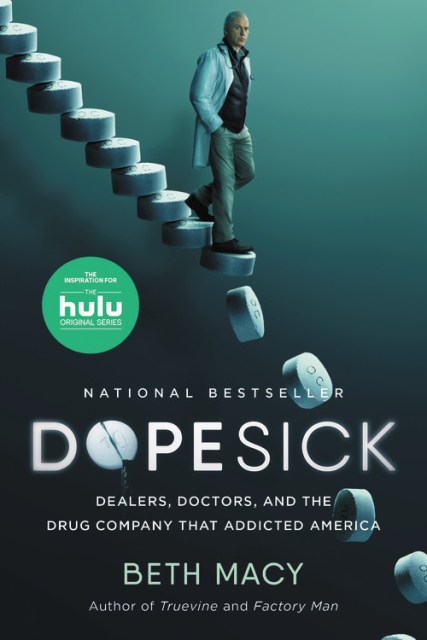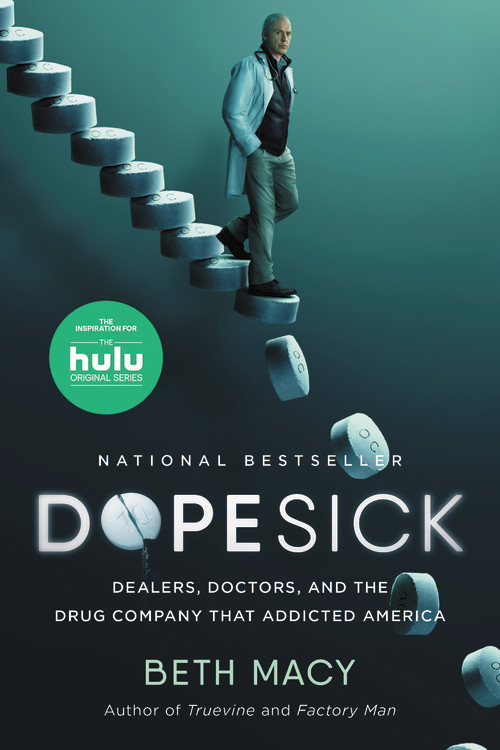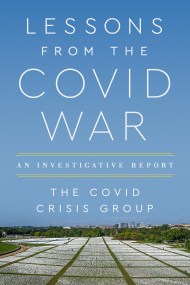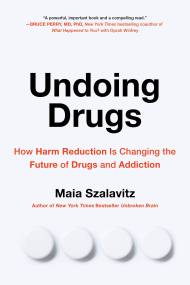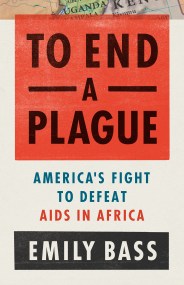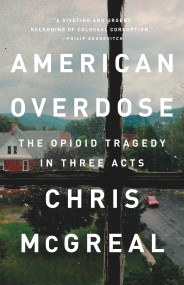Promotion
Shop now and save 20% on your back-to-school purchases & get free shipping on orders $45+ Use code: SCHOOL24
Dopesick
Dealers, Doctors, and the Drug Company that Addicted America
Contributors
By Beth Macy
Formats and Prices
Price
$11.99Price
$15.99 CADFormat
Format:
This item is a preorder. Your payment method will be charged immediately, and the product is expected to ship on or around August 7, 2018. This date is subject to change due to shipping delays beyond our control.
Also available from:
Journalist Beth Macy’s definitive account of America’s opioid epidemic “masterfully interlaces stories of communities in crisis with dark histories of corporate greed and regulatory indifference” (New York Times) — from the boardroom to the courtroom and into the living rooms of Americans.
Beginning with a single dealer who lands in a small Virginia town and sets about turning high school football stars into heroin overdose statistics, Macy sets out to answer a grieving mother’s question-why her only son died-and comes away with a gripping, unputdownable story of greed and need. From the introduction of OxyContin in 1996, Macy investigates the powerful forces that led America’s doctors and patients to embrace a medical culture where overtreatment with painkillers became the norm. In some of the same communities featured in her bestselling book Factory Man, the unemployed use painkillers both to numb the pain of joblessness and pay their bills, while privileged teens trade pills in cul-de-sacs, and even high school standouts fall prey to prostitution, jail, and death.
Through unsparing, compelling, and unforgettably humane portraits of families and first responders determined to ameliorate this epidemic, each facet of the crisis comes into focus. In these politically fragmented times, Beth Macy shows that one thing uniting Americans across geographic, partisan, and class lines is opioid drug abuse. But even in the midst of twin crises in drug abuse and healthcare, Macy finds reason to hope and ample signs of the spirit and tenacity that are helping the countless ordinary people ensnared by addiction build a better future for themselves, their families, and their communities.
“An impressive feat of journalism, monumental in scope and urgent in its implications.” — Jennifer Latson, The Boston Globe
-
A New York Times BestsellerWinner of the 2019 Library of Virginia People's Choice Award in NonfictionLA Times Book Prize for Science & Technology Winner
American Society of Addiction Medicine Annual Media Award Winner
2018 Kirkus Prize Finalist
2019 Library of Virginia People's Choice Award for Nonfiction finalist
2019 Ohioana Book Award in nonfiction finalist
Andrew Carnegie Medal shortlist
800-CEO-READ 2018 Business Book Awards Longlist
A New York Times Bestseller
One of New York Times Book Review's 100 Notable Books of 2018
New York Times critic Janet Maslin's Top Five Best Books
An NPR's On Point Top Title of 2018
One of Literary Hub's Ultimate Best Books of 2018
One of ALA's 2018 Notable Books
A Chicago Tribune Best Book of the Year
One of Atlanta Journal-Constitution'sBest Southern Books of 2018
One of Newsweek's 61 Best Books of 2018
Washington Post Best Book of the Year
An Amazon Best Book of 2018
One of Anne Lamott's Favorite Books of 2018 -
"Macy's harrowing account of the opioid epidemic in which hundreds of thousands have already died masterfully interlaces stories of communities in crisis with dark histories of corporate greed and regulatory indifference."New York Times Book Review, Editors' Choice
-
"A harrowing, deeply compassionate dispatch from the heart of a national emergency...a masterwork of narrative journalism, interlacing stories of communities in crisis with dark histories of corporate greed and regulatory indifference."Jessica Bruder, New York Times Book Review
-
"This book is comprehensive, compassionate and forceful. No matter what you already know about the opiod crisis, Dopesick's toughness and intimacy make it a must."Janet Maslin, New York Times
-
"An impressive feat of journalism, monumental in scope and urgent in its implications...gritty and heartbreaking."Jennifer Latson, The Boston Globe
-
"You've probably heard pieces of this story before, but in Dopesick we get something original: a page-turning explanation."Matt McCarthy, USA Today
-
"Macy has waded into a public health morass that has also become a political minefield...Macy's strengths as a reporter are on full display when she talks to people, gaining the trust of chastened users, grieving families, exhausted medical workers and even a convicted heroin dealer, whose scheduled two-hour interview with the author ended up stretching to more than six hours."Jennifer Szalai, New York Times
-
"Ms. Macy focuses on southern and western Virginia, though the lessons of her narrative apply broadly...Macy embedded herself in the lives of four heartsick families whose children's lives were ravaged--and sometimes lost--because of opioid addiction...for those new to the topic there is much to learn."Dr. Sally Satel, Wall Street Journal
-
"Macy reports on the human carnage with respect and quiet compassion."Gabriel Thompson, The San Francisco Chronicle
-
"Macy's book reveals a more complex truth of an epidemic that has been manufactured by the players of her subtitle."John Warner, The Chicago Tribune
-
"Heartbreaking, exhaustively researched...a fierce indictment of racism, corporate greed and wily dealers...a terrifying, essential read."People's Book of the Week
-
"Macy is a terrific reporter, scrupulous in detailing the significance of her findings...Dopesick's second section--filled with gut-wrenchingly candid interviews with addicts and their families--is the most essential, placing broken faces onto horrifying data sets."David Canfield, Entertainment Weekly
-
"Macy's book doubles as a history and a call to action."Inside the List, New York Times Book Review
-
"In Dopesick, journalist Beth Macy chronicles the crisis at large, and holds a mirror up to the pharmaceutical companies that are fueling it. Macy does exhaustive research for her books and it's encouraging that, despite all she's learned, she still has hope that our country can effectively combat this epidemic."Amazon Book Review
-
"Dopesick pulls together [Macy's] decades of research and interviews to highlight why and how doctors, dealers and drug companies conspired (in some cases knowingly) to get large swaths of the American population addicted to painkillers."Jessica Roy, Deputy Editor of Elle, Best Books of 2018
-
"A ferocious piece of journalism distinguished by unyielding compassion."The Atlanta Journal-Constitution
-
"Beth Macy puts a human face on America's opioid crisis."Christian Science Monitor
-
"Until I read Dopesick by journalist Beth Macy, I didn't grasp all of the factors that have combined to produce the present crisis...Although Macy's stories are set in Virginia, they could happen anywhere in the United States."Susan Okie, The Washington Post
-
"Just as she did with her last book, Truevine, Macy is able to develop an intimacy with key individuals that allows her to understand and explain the hearfelt feelings of her characters...The end result is an on-the-ground survey of the crisis that explores it from both the head and the heart."Paul Markowitz, The National Book Review
-
"Shifting effortlessly between the sociopolitical and the personal, Macy weaves a complex tale that unfolds with all the pace of a thriller, her deep journalism -- interviews with dealers, police officers, activists, local politicians as well as users and their families -- matched by a sense of barely suppressed anger at what is happening to communities like Roanoke, Virginia, where she has lived since 1989."Sean O'Hagan, The Guardian
-
"Beth Macy's recent Dopesick outlined the synergistic destruction that legal and illegal narcotics wreak on users and their communities."Abigail Zuger, The New York Times
-
"A dogged and empathetic reporter on the ills of Appalachia (see her earlier Factory Man), Macy sets her roving eye on the victims and villains of the opioid crisis...Macy's approach is fresh in its humanity and its outlook, which is at once comprehensive and hyperlocal."Boris Kachka, Vulture
-
"Dopesick follows the long chain of preventable, profit-driven human misery that is the opioid crisis."The Approval Matrix, New York Magazine
-
"This book blends memoir and reportage, leaving nearly no stone unturned, looking at the opioid epidemic."Book Riot
-
"The Roanoke, Va.-based writer tasked herself with unravelling a demonically complex issue, and Dopesick is both devastating and sprawling in scope. In part, it's a David-versus-Goliath narrative like her first book, Factory Man."Macleans
-
"A sensitively written and rigorously reported book on the opioid epidemic"Entertainment Weekly
-
"[Macy] brings a clear eye for journalistic detail and a searching humanity to her account of the people who turn to crime to avoid dopesickness...Dopesick will enrage you and bring you to tears, often on the same page.Steve Mitchell, Lit South
-
"[a] masterful work."Misty Hawkins, The Charleston Express
-
"Intensely researched stories about the opioid crisis have been trickling in for a few years, but truly comprehensive books on the topic have just started hitting bookshelves in the last few months. In Dopesick, journalist Beth Macy charts the epidemic in small communities in Central Appalachia, wealthy suburbs, and everywhere in between and details the insidious, indiscriminate effects of addiction."Cristina Arreola, Bustle
-
"Macy potently mixes statistics and hard data with tragic stories of individual sufferers, as well as those who love and attempt to treat them. . . . Macy's forceful and comprehensive overview makes clear the scale and complexity of America's opioid crisis."Publishers Weekly, Starred Review
-
"Award-winning Virginia-based journalist Macy, author of best-sellers Factory Man (2014) and Truevine (2016), carefully constructs the through line from the mid-nineties introduction of the prescription painkiller OxyContin to the current U.S. opioid crisis... Although the realities are devastating, the doctors, the bereaved, and the advocates Macy introduces do offer hope. Hers is a crucial and many-faceted look at a still-unfolding national crisis, making this a timely and necessary read."Booklist, Starred Review
-
"An urgent, eye-opening look at a problem that promises to grow much worse in the face of inaction and indifference."Kirkus, Starred Review
-
"A comprehensive and thoroughly reported book."Mackenzie Dawson, New York Post
-
"Beth Macy wrote a very powerful book. If you haven't read it, I would highly recommend you read Dopesick."Governor Ralph Northam
-
"In this impeccably researched and heartbreaking book, Macy traces the devastating path that opioids have carved through every avenue and back road of America."Bookpage
-
"In Dopesick, Macy brings clarity to what she describes as the 'perfect storm' that created one of the most pressing health emergencies the United States has ever faced...Woven throughout Macy's story is a riveting and heartbreaking human narrative"Travis Lupick, LA Review of Books
-
"Combining her sharp journalistic skills with deep research, Macy dissects all of these causes and their ensuing disastrous effects, giving Dopesick ambitious scope."B&N Review
-
"With both compassion and no-bull reporting, Roanaoke, Virginia-based journalist Beth Macy delivers the first book to completely chart America's current opioid crisis."Garden and Gun
-
"Beth Macy turns her prodigious reporting and writing skills to the opioid crisis...show[ing] how the pharmaceutical company pushed this powerful drug, giving million-dollar bonuses to sales reps and rewarding doctors with gifts and trips...A harrowing, infuriating, eye-opening book."Laurie Hertzel, Star Tribune
-
"It is difficult to imagine a deeper and more heartbreaking examination of America's opioid crisis than this new book by investigative reporter Beth Macy of Roanoke."Jeff Debell, Roanoke Times
-
"Macy digs into the explosion of opioid addiction in Appalachia, in a book that is a scorching indictment of American greed and indifference."Gabriel Thompson, Datebook
-
"Brilliant, harrowing, humane ... you feel her compassion for these people."Bill Goldstein, NBC New York 4
-
"Beth Macy gives the opioid epidemic a human face, but not at the expense of historical and scientific context."Plough Quarterly
-
"If you're trying to make sense of why an opioid epidemic is raging in the richest nation in the history of the world - and raging it is, with 174 overdose deaths a day in the United States in 2016, triple the rate from 1999, according to the Centers for Disease Control - we'd suggest you buy and read the book Dopesick."Richmond Times Dispatch
-
"Dopesick is nonfiction, but it unfolds like a tragedy, in a place that receives little national attention outside of election years...accomplishes something American drug policy hasn't: It presents addicted persons as morally complex, fully formed human beings whose problems have medical and political solutions."Sarah Jones, Democracy Journal
-
"A warning to everyone in America who thinks that the opiate epidemic won't arrive at their doorstep. "Paula Rinehart, The Federalist
-
"A searing account of the U.S. opioid epidemic . . . what makes Macy's book so devastating are her intimate portraits of addicts and their tortured families, trapped in the cycle of addiction, recovery and relapse."Shelf Awareness for Readers
-
"Macy's use of current research by various experts makes clear how complex the opioid problem is, but the strength of this narrative comes from the people in the day-to-day battle."Library Journal
-
"Macy's in-depth, personal portraits of those that have been lost, and the families members left behind, are both a gut punch and--beyond the righteous anger at those responsible--the heartbreaking beauty of the book."800-CEO-READ
-
"Dopesick largely reads as a human interest story, a series of intertwined portrayals of grief and terror...These painful and personal stories form the heart of Macy's book and make it perhaps the most empathic of the volumes regarding the epidemic...But to describe Dopesick simply as a series of human interest stories shortchanges its comprehensiveness."Arthur Robin Williams, M.D. and Frances R. Levin, M.D., Cerebrum
-
"Beth Macy writes about our opioid epidemic but Dopesick is not about the drugs. It's a book about kids and moms and neighbors and the people who try to save them. It's about shame and stigma and desperation. It's about bad policy, greed and corruption. It's a Greek tragedy with a chorus of teenage ghosts who know how to text but can't express how they feel."Senator Tim Kaine
-
"Everyone should read Beth Macy's story of the American opioid epidemic, of suffering, of heroism and stupidity, and of the corporate greed and regulatory failure that lies behind it. With compassion and humanity, Macy takes us into the lives of the victims, their families, law enforcement, and even some of the criminals. A great book!"Professor Anne C Case, Professor of Economics and Public Affairs, Emeritus at Princeton University and Sir Angus Deaton, FBA HonFRSE and winner of the Nobel Prize in Economics
-
"She's a good journalist, and she tells this story in a way that implores you to care. In the pages of Dopesick, you'll meet mothers and their children, people like Kristi and Jesse, Janine and Bobby, Robin and Scott, Patricia and Tess. People I know...some are doctors or nurses. Your heart will break like mine has. Honest, rational, and respectful discussion of opioid addiction is an essential starting point for any successful effort to push back against it."Nancy Howell Agee, Becker's Hospital Review and President of the American Hospital Assosiation
-
"It's a tragic story, beautifully told, but redemption comes in the heroic figures of patients, parents, judges, physicians, and prosecutors and others who did the right thing. Dopesick is the best exploration I have read of an epidemic that is very much with us."Abraham Verghese, author of My Own Country and Cutting for Stone
-
"Beth Macy is not satisfied with myths or side-bars. She seeks the very hearts of the people who are running the long marathons of struggle and survival - of Life. Dopesick is another deep - and deeply needed - look into the troubled soul of America."Tom Hanks
-
"I'm still in withdrawal from Dopesick, a harrowing journey through the history and contemporary hell-scape of drug addiction. Beth Macy brings a big heart, a sharp eye, and a powerful sense of place to the story of ordinary Americans in the grip of an extraordinary crisis."Tony Horwitz, Pulitzer Prize winning author of the National bestseller Confederates in the Attic
-
"With the greatest compassion, Beth Macy plunges us into a world that deserves our knowing, filled with grieving mothers, cut-throat pharmaceutical executives, determined first-responders, and indifferent lawmakers. Radiating out from Appalachia, where the collision of poverty and pain created the ghoulish market for OxyContin, to the quiet addiction of suburbs and farming communities, you will recognize this world and weep for it. And then you will want to change it, because there can be no other response. Dopesick is both a tribute to those who lost and a fierce rebuke to those who took, and the new guidebook for understanding this quintessentially American crisis."Elizabeth Catte, author of What You Are Getting Wrong About Appalachia
-
"Dopesick will make you shudder with rage and weep with sympathy. Beth Macy's empathy and fearless reporting reaches beyond the headlines to tell the stories of how real people have been left to cope with the fallout of corporate greed, and the willful blindnesses of businesses and the government. Macy again shows why she's one of America's best non-fiction writers"Brian Alexander, author of Glass House
-
"All prior books on this topic, including my own, were written as if describing the trunk, the ear, or the tail, without quite capturing the whole elephant. Journalist Beth Macy has packed the entire elephant and then some into one book. Her writing jumps from the page with a fast-paced narrative, colorful and inspiring characters, vivid historical detail, and a profound sense of place."Anna Lembke, author of Drug Dealer, M.D., psychiatrist and professor of addiction medicine at Stanford University School of Medicine
- On Sale
- Aug 7, 2018
- Page Count
- 384 pages
- Publisher
- Little, Brown and Company
- ISBN-13
- 9780316551281
Newsletter Signup
By clicking ‘Sign Up,’ I acknowledge that I have read and agree to Hachette Book Group’s Privacy Policy and Terms of Use
